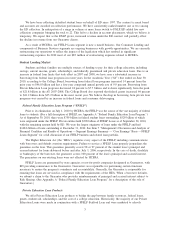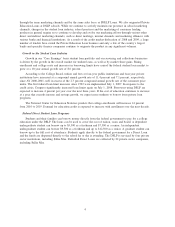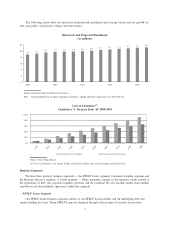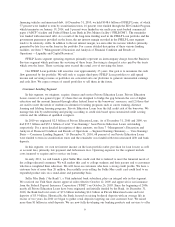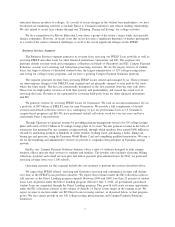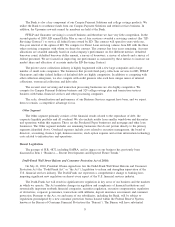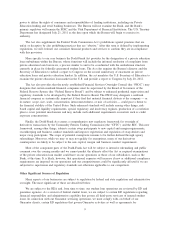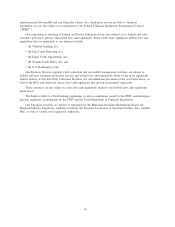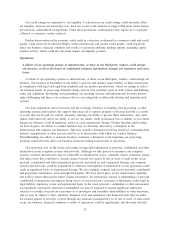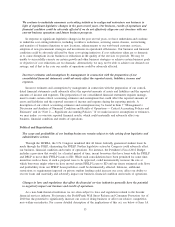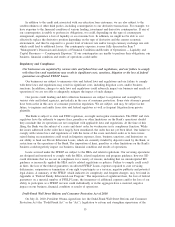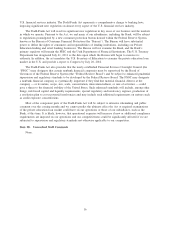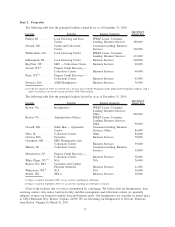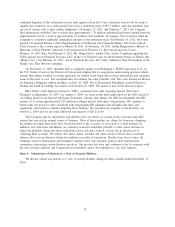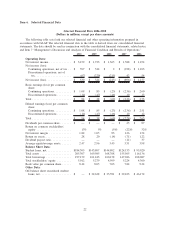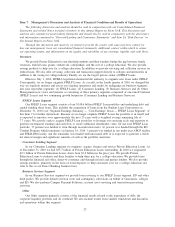Sallie Mae 2010 Annual Report Download - page 14
Download and view the complete annual report
Please find page 14 of the 2010 Sallie Mae annual report below. You can navigate through the pages in the report by either clicking on the pages listed below, or by using the keyword search tool below to find specific information within the annual report.We continue to undertake numerous cost-cutting initiatives to realign and restructure our business in
light of significant legislative changes in the past several years. Our business, results of operations and
financial condition could be adversely affected if we do not effectively align our cost structure with our
current business operations and future business prospects.
In response to significant legislative changes in the past several years, we have undertaken and continue
to undertake cost-cutting initiatives, including workforce reductions, servicing center closures, restructuring
and transfers of business functions to new locations, enhancements to our web-based customer services,
adoption of new procurement strategies and investments in operational efficiencies. Our business and financial
condition could be adversely affected by these cost-cutting initiatives if cost reductions taken are so dramatic
as to cause disruptions in our business or reductions in the quality of the services we provide. We may be
unable to successfully execute on certain growth and other business strategies or achieve certain business goals
or objectives if cost reductions are too dramatic. Alternatively, we may not be able to achieve our desired cost
savings, and if that is the case our results of operations could be adversely affected.
Incorrect estimates and assumptions by management in connection with the preparation of our
consolidated financial statements could adversely affect the reported assets, liabilities, income and
expenses.
Incorrect estimates and assumptions by management in connection with the preparation of our consoli-
dated financial statements could adversely affect the reported amounts of assets and liabilities and the reported
amounts of income and expenses. The preparation of our consolidated financial statements requires manage-
ment to make certain critical accounting estimates and assumptions that could affect the reported amounts of
assets and liabilities and the reported amounts of income and expense during the reporting periods. A
description of our critical accounting estimates and assumptions may be found in Item 7 “Management’s
Discussion and Analysis of Financial Condition and Results of Operations — Critical Accounting Policies and
Estimates” and in “Note 2 — Significant Accounting Policies.” If we make incorrect assumptions or estimates,
we may under- or overstate reported financial results, which could materially and adversely affect our
business, financial condition and results of operations.
Political and Reputational.
The scope and profitability of our lending businesses remain subject to risks arising from legislative and
administrative actions.
Through the HCERA, the U.S. Congress mandated that all future federally guaranteed student loans be
made through the DSLP, eliminating the FFELP. Further legislative action by Congress could adversely affect
our business, financial condition and results of operations. For instance, the President’s Fiscal 2012 Budget
includes a provision that would, for a limited period of time, incent borrowers that have loans with the FFELP
and DSLP to move their FFELP Loans to ED. While such consolidations have been permitted for some time,
incentives such as these, if such a proposal were to be approved, could incrementally increase the rate at
which borrowers might otherwise have moved certain FFELP Loans to ED and our future estimated cash flows
and profitability from our FFELP Loan portfolios could be detrimentally affected. Likewise, additional
restrictions or requirements imposed on private student lending could increase our costs, affect our ability to
recover loans and materially and adversely impact our business, financial condition and results of operations.
Changes in laws and regulations that affect the financial services industries generally have the potential
to negatively impact our business and results of operations.
As a non-bank financial institution we are often subject to laws and regulations related to the broader
financial services industry. For instance, the Dodd-Frank Wall Street Reform and Consumer Protection Act of
2010 has the potential to significantly increase our costs of doing business or affect our relative competitive-
ness within our industry. For a more detailed description of the implications of this act, see below at Item 1A
13


